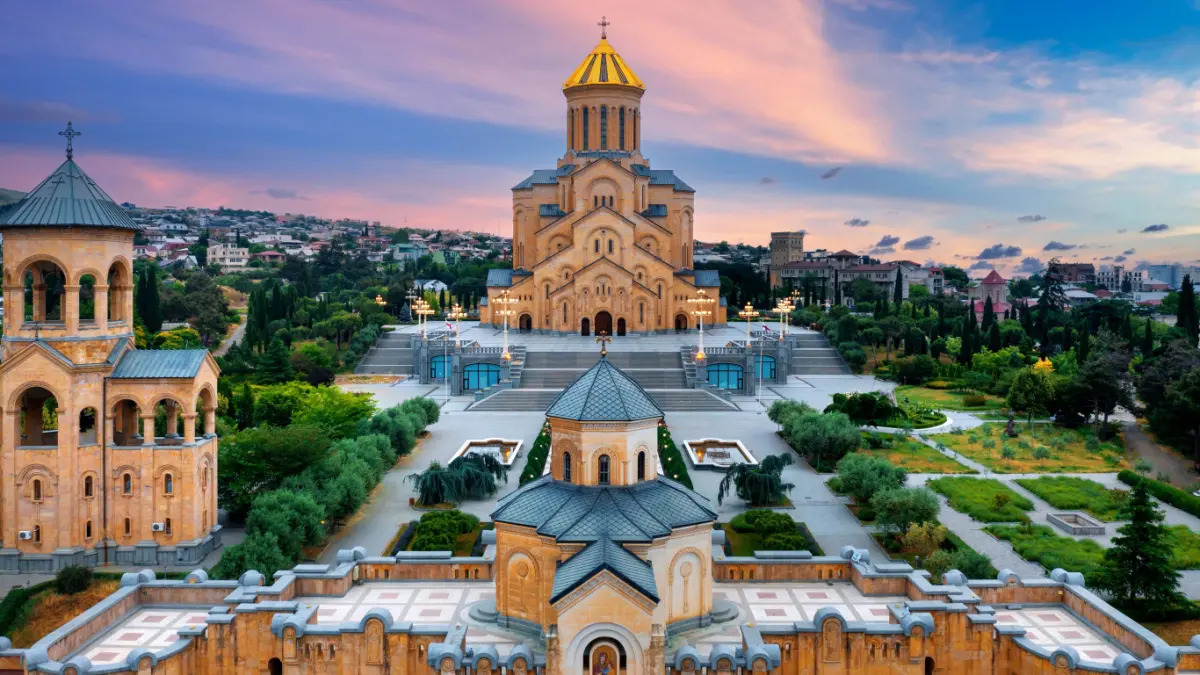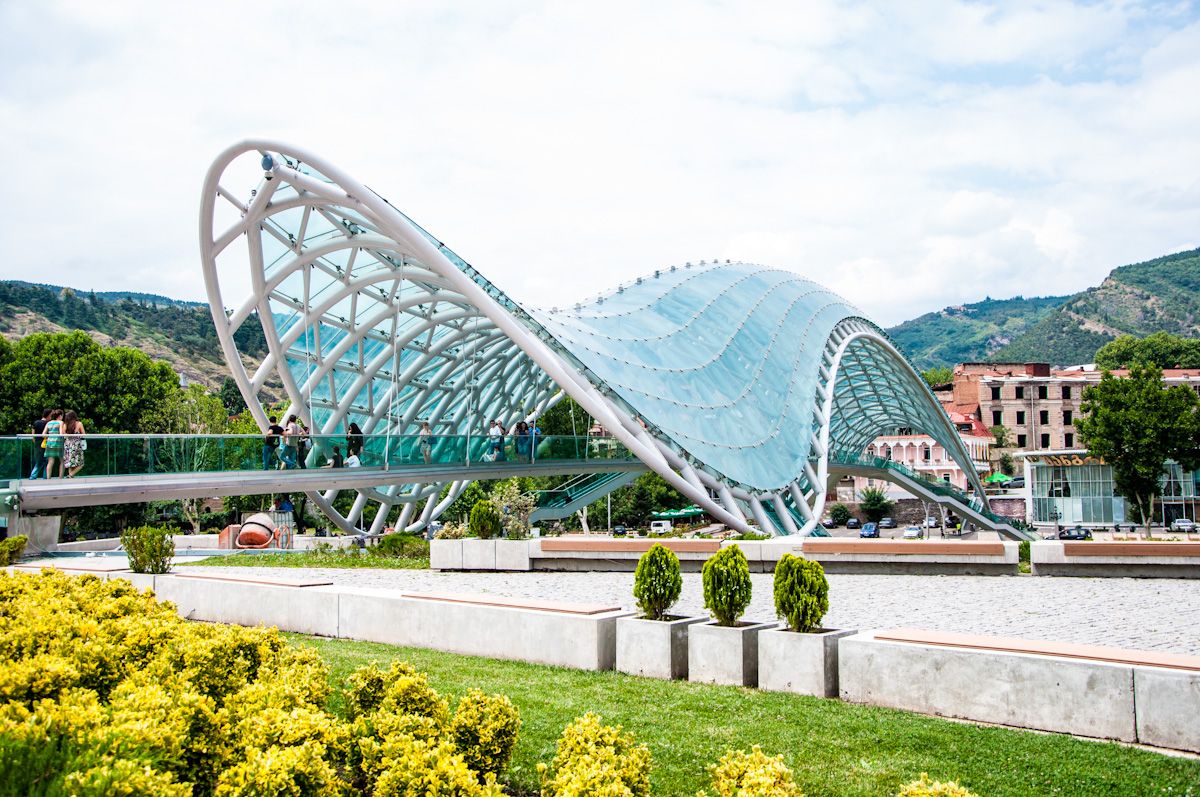



トビリシ(グルジア語: თბილისი, Tbilisi [tʰb̥ilisi] (![]() 音声ファイル)、略称TBS)は、ジョージア国(グルジア)の首都。ときにティフリス(Tiflis)とも呼ばれる。トビリシとは「あたたかい」を意味するトビリに由来し、温泉と関係あるとされている。元史には梯弗里斯とも呼ばれる。人口は約110万人。
音声ファイル)、略称TBS)は、ジョージア国(グルジア)の首都。ときにティフリス(Tiflis)とも呼ばれる。トビリシとは「あたたかい」を意味するトビリに由来し、温泉と関係あるとされている。元史には梯弗里斯とも呼ばれる。人口は約110万人。
ジョージア国東部、クラ川の河畔に広がる。三方を山や小高い丘に囲まれている。
Tbilisi (English: /təbɪˈliːsi, təˈbɪlɪsi/ tə-bih-LEE-see, tə-BIL-ih-see;[6] Georgian: თბილისი [tʰbilisi] (![]() listen)), in some countries also still known by its pre-1936 international designation Tiflis[7] (/ˈtɪflɪs/ TIF-lis),[6] is the capital and the largest city of Georgia, lying on the banks of the Kura River with a population of approximately 1.5 million people. Founded in the 5th century AD by Vakhtang I of Iberia, since then Tbilisi served as the capital of various Georgian kingdoms and republics. Between 1801 and 1917, then part of the Russian Empire, Tbilisi was the seat of the Imperial Viceroy, governing both Southern and Northern Caucasus.
listen)), in some countries also still known by its pre-1936 international designation Tiflis[7] (/ˈtɪflɪs/ TIF-lis),[6] is the capital and the largest city of Georgia, lying on the banks of the Kura River with a population of approximately 1.5 million people. Founded in the 5th century AD by Vakhtang I of Iberia, since then Tbilisi served as the capital of various Georgian kingdoms and republics. Between 1801 and 1917, then part of the Russian Empire, Tbilisi was the seat of the Imperial Viceroy, governing both Southern and Northern Caucasus.
Because of its location on the crossroads between Europe and Asia, and its proximity to the lucrative Silk Road, throughout history Tbilisi was a point of contention among various global powers. The city's location to this day ensures its position as an important transit route for various energy and trade projects. Tbilisi's diverse history is reflected in its architecture, which is a mix of medieval, neoclassical, Beaux Arts, Art Nouveau, Stalinist and the Modern structures.
Historically, Tbilisi has been home to people of multiple cultural, ethnic, and religious backgrounds, though it is currently overwhelmingly Eastern Orthodox Christian. Its notable tourist destinations include cathedrals Sameba and Sioni, Freedom Square, Rustaveli Avenue and Agmashenebeli Avenue, medieval Narikala Fortress, the pseudo-Moorish Opera Theater, and the Georgian National Museum.
Tbilissi (en géorgien თბილისი, t'bi-li-si) est la capitale de la République de Géorgie, sur les rives de la rivière Koura (ou Mt'kvari).
Son nom dérive de l'ancien géorgien Tp'ilisi ((source) chaude). Appelée traditionnellement Tiflis dans la plupart des langues (la terminaison -i est une marque de la langue géorgienne), son nom local s'est répandu par la volonté de Staline à partir de 1935. La ville couvre une superficie de 726 km2 et abrite 1 113 000 habitants au 1er janvier 2016 selon l'Office national des statistiques de Géorgie1.
Tbilisi (in georgiano: თბილისი?) è la capitale e la maggiore città della Georgia, già capitale della RSS Georgiana e della RSSF Transcaucasica. Il nome è talvolta scritto nelle forme Tiflis, Tiblisi o anche Tbilissi. La città copre un'area di 726 km² e ha 1 118 035 abitanti.
Tiflis1 (en georgiano თბილისი Tbilisi) es la capital de Georgia y la mayor ciudad del país. Está a orillas del río Kurá (მტკვარი, Mt'k'vari) y tiene 1 345 000 habitantes y una superficie de 726 km².
Fundada en el siglo V por Vakhtang Gorgasali, el monarca de la antigua región de Iberia caucásica, también conocida como Kartli, Tiflis ha sido, con algunas interrupciones, la capital de Georgia. La historia de la ciudad puede ser vista por su arquitectura: el estilo de la avenida Rustaveli, diseñada por el barón Haussmann, y el del centro, están mezclados con el de las estrechas calles del distrito medieval de Narikala. Tiflis es un importante centro industrial, social y cultural. La ciudad es una importante ruta de tránsito de la energía mundial y el comercio. Localizada estratégicamente entre Europa y Asia y antiguamente situada en la Ruta de la Seda, Tiflis ha sido a menudo un punto clave en las relaciones de imperios rivales.
La demografía de la ciudad es diversa e históricamente ha sido hogar de gente de diferentes etnias, religión y cultura. Recientemente, Tiflis ha sido conocida por la pacífica Revolución de las rosas, que tuvo lugar en la plaza de la Libertad y lugares cercanos. A consecuencia de ello, el entonces presidente, Eduard Shevardnadze, fue desplazado del poder.
El gentilicio es teflisense o teflitano, de conformidad con el nombre latino de la diócesis que existió en los siglos XV y XVI.2
La ciudad cuenta con un aeropuerto internacional. Sus principales lugares turísticos son la catedral de Sameba, la plaza de la Libertad, la catedral de Sioni, Metekhi, Narikala, el Parlamento de Georgia, la avenida Rustaveli, el Teatro de la Ópera y el Ballet, la basílica de Anchiskhati, la montaña de Mtatsminda y la iglesia de Kashveti, cerca de la cual se encuentran el Museo nacional de Georgia, el Museo Histórico y numerosas galerías de arte. La ciudad fue inmortalizada por los pintores Niko Pirosmani y Lado Gudiashvili.
Тбили́си (груз. თბილისი tʰ'biliˌsi Tbilisi.ogg [7][8] — «тёплый источник», старое название — Тифлис) — столица[9] и крупнейший город Грузии, расположенный на берегу реки Куры с населением около 1,1 миллиона человек. Город был основан в V веке. Стратегическое расположение на перекрёстке между Европой и Азией неоднократно делало Тбилиси яблоком раздора между различными силами на Кавказе. Многоликую историю города можно изучать по его архитектуре: начиная с просторных проспектов Руставели и Агмашенебели, и заканчивая узкими улицами сохранившегося с раннего Средневековья района Нарикала.
Составляет приравненный к краю муниципалитет Тбилиси, который занимает площадь 726 км²[1] с населением 1 113 000 человек (по оценке на 2016 год)[4] или 1 108 717 человек (по переписи 2014 года), в том числе в собственно городе проживает 1 062 282 человек (2014 год), в 4 посёлках городского типа — 16 015 человек (2014 год), в 22 сельских населённых пунктах — 30 420 человек (2014 год)[10][11]. По оценке на 2016 год численность населения города (с учётом 4 пгт) составила 1 082 400 человек.[2]












